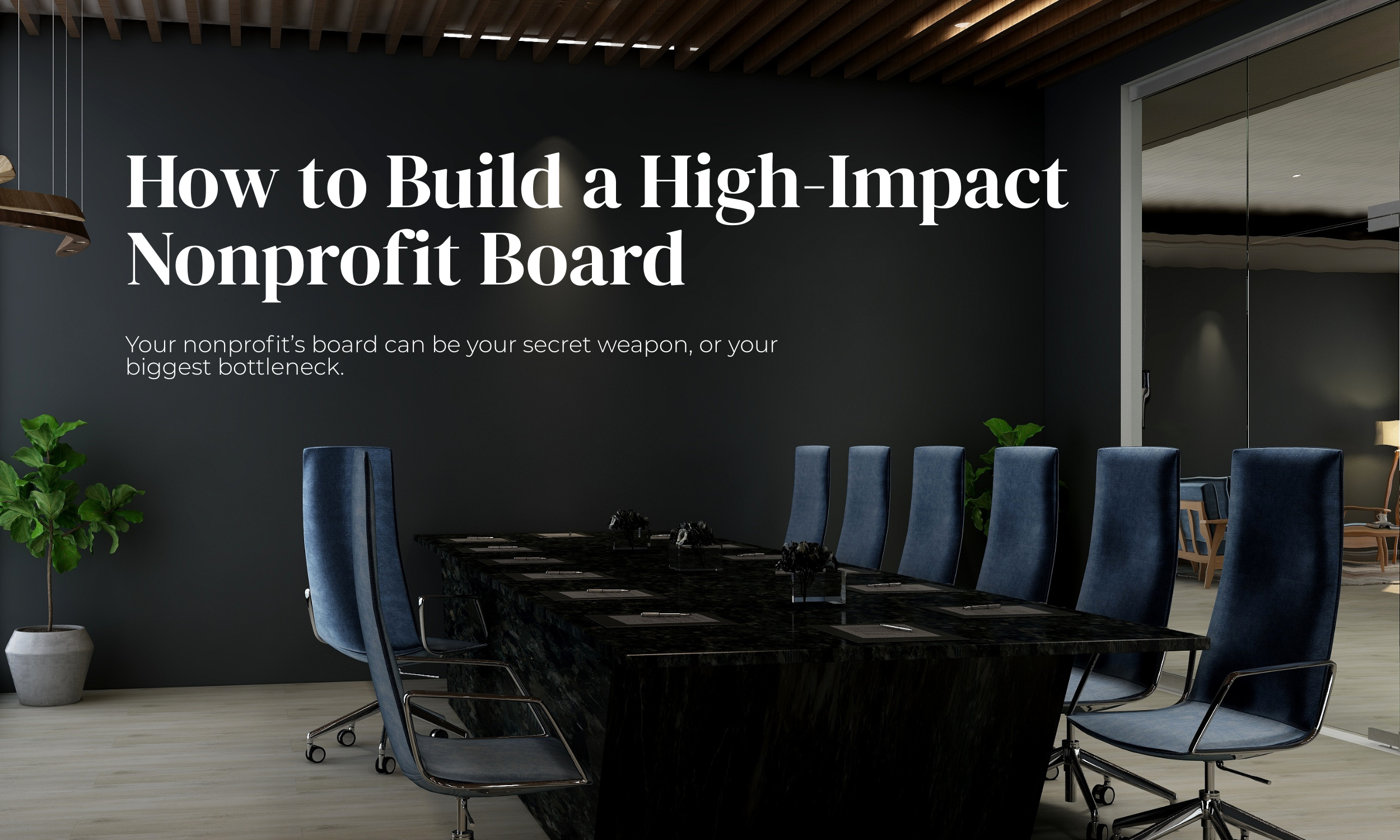How to Build a High-Impact Nonprofit Board
Your nonprofit’s board can be your secret weapon, or your biggest bottleneck.
A truly high-impact board isn’t just a list of names on your website or a group that meets quarterly to nod along at financial reports. It’s a team of engaged, mission-driven leaders who bring their expertise, networks, and influence to the table, actively fueling your organization’s growth.
Yet far too many boards operate on autopilot, with unclear expectations, minimal involvement outside of meetings, and a mismatch between skills and needs. If your board’s potential feels untapped, or worse, like a source of frustration, it’s time to change that.
In this guide, we’ll walk through a proven, step-by-step process to build a high-impact nonprofit board that drives your mission forward.
Step 1: Define Your Ideal Board Profile
You can’t build a powerhouse board without knowing what “powerhouse” means for your organization. Start by defining the skills, experience, and diversity your mission truly needs. Do you need legal expertise? Someone with deep community connections? A financial strategist? A seasoned fundraiser?
This is your board competency matrix, a document that maps out your current board’s strengths and gaps. From there, you can intentionally recruit to fill those gaps instead of just accepting whoever is willing to serve.
Action Tip: Include both hard skills (finance, marketing, governance) and soft skills (collaboration, problem-solving, strategic thinking). Aim for diversity in backgrounds, perspectives, and demographics to bring fresh insight into every decision.
Step 2: Set Clear Expectations from Day One
The number one reason board members underperform? They never knew what was expected in the first place. From the start, be transparent about time commitments, fundraising expectations, meeting attendance, and advocacy responsibilities. Create a written board agreement that outlines these commitments and review it with every incoming member.
Pro Insight: Many nonprofits avoid setting fundraising expectations for fear of scaring people away. The truth? The right people will appreciate the clarity, and it will weed out those who aren’t prepared to contribute meaningfully.
Step 3: Recruit Strategically, Not Desperately
Scrambling to fill empty seats is one of the fastest ways to end up with a disengaged board. Recruitment should be an ongoing process, not a last-minute scramble. Tap into your existing network, engage prospective members in volunteer roles first, and clearly communicate why you believe they’re the right fit.
Example: Instead of posting “We need board members,” invite a local business leader to serve on an event planning committee. If they shine there, extend a formal invitation to join the board.
Step 4: Onboard Like It Matters - Because It Does
Board orientation is more than handing over a binder of bylaws. It’s your chance to ignite passion, clarify roles, and set the tone for active engagement.
A strong onboarding process includes:
A deep dive into your mission, history, and impact.
Introductions to key staff and fellow board members.
A walkthrough of your current strategic plan.
Clarity on financial responsibilities and decision-making authority.
When new members leave their first meeting, they should feel empowered, informed, and excited, not overwhelmed or unsure.
Step 5: Keep Engagement High Year-Round
High-impact boards don’t just show up for meetings, they contribute in between.
To keep members engaged:
Assign each member a specific committee or project.
Share regular mission updates, successes, and challenges.
Celebrate wins, both organizational and individual board contributions.
And remember: engagement is a two-way street. Ask board members how you can support them in being more effective advocates for your cause.
Step 6: Hold Members Accountable
Accountability isn’t about policing, it’s about honoring the mission. If a member repeatedly misses meetings, ignores fundraising commitments, or fails to engage, address it directly. Use your board agreement as the framework for the conversation. In some cases, the best outcome is helping that person step down gracefully to make space for someone ready to contribute.
High-impact boards thrive when every member pulls their weight.
Step 7: Invest in Your Board’s Growth
Your board should evolve alongside your organization. Offer ongoing training in fundraising, governance, and leadership. Bring in guest speakers, attend conferences together, or hold strategy retreats to refresh energy and perspective.
Not only does this improve their ability to serve, it reinforces the value of their time and commitment.
Step 8: Evaluate and Adapt
Once a year, conduct a board self-assessment. Ask members to reflect on their own contributions and the board’s collective effectiveness. Use the results to refine your recruitment, onboarding, and engagement strategies.
High-impact boards don’t happen by accident, they’re built through intentional effort and regular evaluation.
The Alora Advantage
Because strategy should be your greatest asset.
At Alora, we don’t just help nonprofits fill board seats, we help them fill the right seats with the right people. Through The Brand Lab, we guide organizations in clarifying their identity, building a recruitment pipeline, and creating engagement systems that make every board member a true ambassador for your mission.
If you’re ready to stop settling for “good enough” and start building a board that drives measurable impact, let’s talk.


